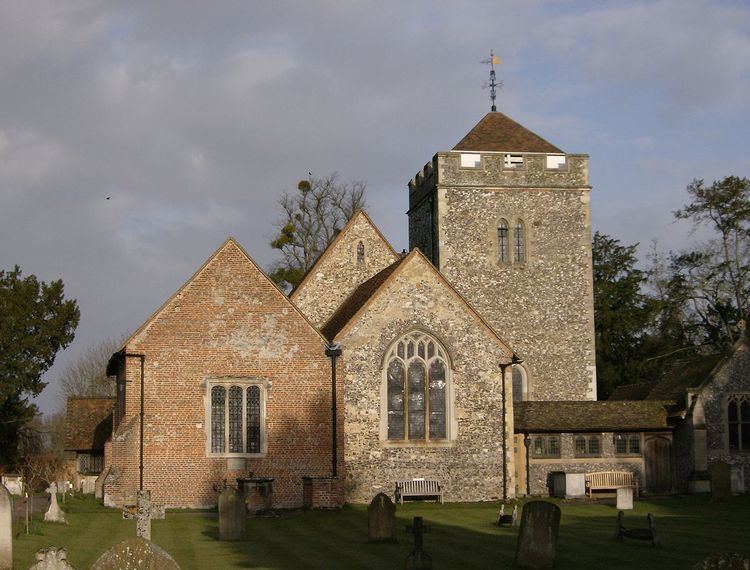Population 4,752 (2011 census) Civil parish Stoke Poges Area 10.09 km² Local time Tuesday 11:50 AM Dialling code 01753 | OS grid reference SU9884 Sovereign state United Kingdom District South Bucks | |
 | ||
Weather 15°C, Wind SW at 14 km/h, 65% Humidity | ||
5 bedroom detached house for sale in stoke poges buckinghamshire 1 670 000
Stoke Poges is a green-buffered scattered village and civil parish in the South Bucks district of Buckinghamshire, England. It is centred approximately three miles north of Slough (historically Upton-cum-Chalvey), its post town, and a mile east of Farnham Common.
Contents
- 5 bedroom detached house for sale in stoke poges buckinghamshire 1 670 000
- Map of Stoke Poges Slough UK
- Taylor wimpey hastings court stoke poges
- Origin of the name
- Stoke Poges manor house
- Education
- St Giles church
- In film fiction and the media
- Notable natives and residents
- Notable organizations
- Demography
- Geography
- References
Map of Stoke Poges, Slough, UK
Taylor wimpey hastings court stoke poges
Origin of the name
In the name Stoke Poges, stoke means "stockaded (place)" that is staked with more than just boundary-marking stakes. In the Domesday Book of 1086, the village was recorded as Stoche. William Fitz-Ansculf, who held the manor in 1086 (in the grounds of which the Norman parish church was built), later became known as William Stoches or William of Stoke. Two hundred years after William, Amicia of Stoke, heiress to the manor, married Robert Pogeys, Knight of the Shire, and the village eventually became known as Stoke Poges. The spelling appearing as "Stoke Pocheys", if applicable to this village, may suggest the pronunciation of the second part to have a slightly more open "o" sound compared with the word "Stoke".
Stoke Poges manor house
A manor house at Stoke Poges was built before the Norman Conquest and was mentioned in the 1086 Domesday Book. In 1555 the then-owner, Francis Hastings, 2nd Earl of Huntingdon, pulled down much of the existing fortified house. He replaced it with a large Tudor brick-built house, with numerous chimneys and gables. In 1599 it was acquired by Sir Edward Coke, who is said to have entertained Queen Elizabeth I there in 1601.
A few decades later, the married lady of the manor, Lady Purbeck, had a love affair with Robert Howard, a member of parliament. The affair's discovery was received as a scandal upon the three people involved, and in 1635 Lady Purbeck was imprisoned for adultery. She escaped from prison to France, but later returned to Stoke Poges, where she died in 1645.
King Charles I was imprisoned at the manor house in 1647 before his execution.
Later the manor came into the possession of Thomas Penn, a son of William Penn who founded Pennsylvania and was its first proprietor. Thomas Penn held three-fourths of the proprietorship. The manor property remained in his family for at least two generations, as his son John Penn "of Stoke" also lived there.
Thomas Gray's 1750 poem, "A Long Story," describes the house and its occupants. Sir Edwin Henry Landseer was a frequent visitor to the house and rented it as a studio for some time. His most famous painting, The Monarch of the Glen (1851), is said to have been created at Stoke Poges, with the deer in the park used as models.
Education
The village has a primary school, The Stoke Poges School, which admits children residing in the catchment area aged 5–11.
St Giles' church
Gray's "Elegy Written in a Country Churchyard" is believed to have been written in the churchyard of the Church of England parish church of Saint Giles in Stoke Poges, also known as the Stoke Poges Church. Other churches have claimed the honour, including St Laurence's in Upton and St. Mary's in Everdon, Northamptonshire.
Gray is buried at St Giles'. John Penn "of Stoke" had a large monument built, displaying verses from the Elegy, nearby.
The Georgian rectory was built by Thomas Penn of Stoke Park in 1765. It is now a private residence called Elegy House.
In film, fiction and the media
Notable natives and residents
Notable organizations
Demography
At the 2001 UK census, the Stoke Poges electoral ward had a population of 4,839. The ethnicity was 93.3% white, 1.3% mixed race, 4.8% Asian, 0.3% black and 0.3% other. The place of birth of residents was 88.1% United Kingdom, 1.6% Republic of Ireland, 2.5% other Western European countries, and 7.8% elsewhere. Religion was recorded as 76.5% Christian, 0.2% Buddhist, 0.7% Hindu, 2.7% Sikh, 0.5% Jewish, and 1.1% Muslim. 10.6% were recorded as having no religion, 0.2% had an alternative religion and 7.6% did not state their religion.
The economic activity of residents aged 16–74 was 40.8% in full-time employment, 11.6% in part-time employment, 12.6% self-employed, 1.8% unemployed, 1.5% students with jobs, 3.1% students without jobs, 16.8% retired, 6.7% looking after home or family, 2.5% permanently sick or disabled and 2.5% economically inactive for other reasons. The industry of employment of residents was 15.4% retail, 13.4% manufacturing, 6.9% construction, 21.1% real estate, 9.2% health and social work, 7.3% education, 8.8% transport and communications, 3.5% public administration, 3.4% hotels and restaurants, 2.8% finance, 0.8% agriculture and 7.4% other. Compared with national figures, the ward had a relatively high proportion of workers in real estate, transport and communications. According to Office for National Statistics estimates, during the period of April 2001 to March 2002 the average gross weekly income of households was £870, compared with an average of £660 in South East England. Of the ward's residents aged 16–74, 28.4% had a higher education qualification or the equivalent, compared with 19.9% nationwide.
In 2011, The Daily Telegraph deemed Stoke Poges as Britain's eighth richest village and the third richest village in Buckinghamshire.
Geography
Hamlets within Stoke Poges parish include:
